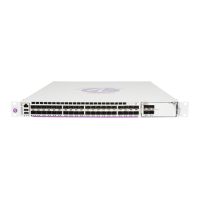VRRP
7705 SAR OS Router Configuration Guide 223
Outside hosts are the network entities that generate the IP user traffic. VRRP communication
occurs between the routers on the subnet that are using VRRP. The availability of routes and/
or hosts can influence the priority of a VRRP router, making the priority variable. If a backup
router loses the ability to route to some destinations, its VRRP priority is reduced, making it
less desirable as a backup router in case the master fails.
Explicit events override all delta events. If multiple explicit events occur, the event with the
lowest priority value is assigned to the in-use priority. As events clear, the in-use priority is
reevaluated accordingly and adjusted dynamically.
Delta priority events also have priority values. If no explicit events have occurred within the
policy, the sum of the occurring delta events priorities is subtracted from the base priority of
each virtual router instance. If the result is lower than the delta in-use priority limit, the delta
in-use priority limit is used as the in-use priority for the virtual router instance. Otherwise, the
in-use priority is set to the base priority less the sum of the delta events.
Each event generates a VRRP priority event message indicating the policy ID, the event type,
the priority type (delta or explicit) and the event priority value. Another log message is
generated if the event is no longer true, indicating that the event has been cleared.
Priority Event Hold-set Timers
Hold-set timers are used to dampen the effect of a flapping event. A flapping event is where
the event continually transitions between clear and set. The hold-set timer prevents a set event
from transitioning to the cleared state until it expires.
Each time an event transitions between cleared and set, the timer begins to count down to 0.
If the timer reaches 0, the event is allowed to enter the cleared state once more. Entering the
cleared state is always dependent on the object controlling the event conforming to the
requirements defined in the event itself. It is possible, on some event types, to have a further
set action reset the hold-set timer. This extends the amount of time that must expire before
entering the cleared state.
Port Down Priority Event
The port down priority event is tied to a physical port. The port operational state is evaluated
to determine a port down priority event or event clear.
If the port operational state is up, the port down priority event is considered false or cleared.
If the port operational state is down, the port down priority event is considered true or set.

